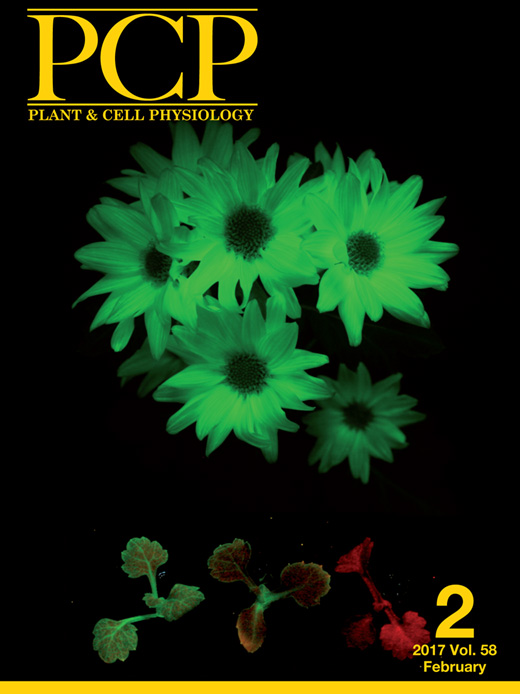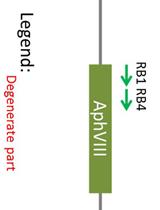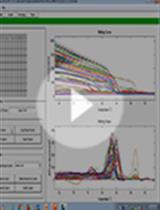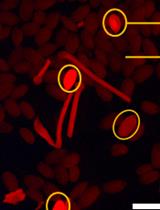- EN - English
- CN - 中文
Construction of Antisense RNA-mediated Gene Knock-down Strains in the Cyanobacterium Anabaena sp. PCC 7120
反义RNA介导的鱼腥藻PCC 7120基因敲降株的构建
发布: 2020年02月20日第10卷第4期 DOI: 10.21769/BioProtoc.3528 浏览次数: 5672
评审: Dennis J Nürnberg Cheng Cai ZhangAnonymous reviewer(s)
Abstract
Anabaena sp. PCC 7120 (hereafter Anabaena) is a model cyanobacterium to study nitrogen fixation, cellular differentiation and several other key biological functions that are analogous in plants. As with any other organism, many genes in Anabaena encode an essential life function and hence cannot be deleted, causing a bottleneck in the elucidation of its genomic function. Antisense RNA (asRNA) mediated approach renders the study of essential genes possible by suppressing (but not completely eliminating) expression of the target gene, thus allowing them to function to some extent. Recently, we have successfully implemented this approach using the strong endogenous promoter of the psbA1 gene (D1 subunit of Photosystem II) introduced into a high-copy replicative plasmid (pAM1956) to suppress the transcript level of the target gene alr0277 (encoding a sigma factor, SigJ/Alr0277) in Anabaena. This protocol represents an efficient and easy procedure to further explore the functional genomics, expanding the scope of basic and applied research in these ecologically important cyanobacteria.
Keywords: AntisenseRNA (asRNA) (反义RNA)Background
Cyanobacteria, a diverse phylum of aerobic bacteria capable of photosynthesis, require light (solar energy), carbon dioxide and trace elements for growth. They are genetically amenable due to the availability of facile molecular biology techniques and efficient conjugation systems for the transfer of foreign genes into them (Wolk et al., 1984; Elhai et al., 1997). Anabaena is a filamentous cyanobacterium, which is capable of cellular differentiation, wherein specialised cells (termed heterocysts) carry out nitrogen fixation. Classical strategies such as gene knockout to disrupt the function of a “gene of interest” have been widely employed in cyanobacteria in order to understand their function. Following transformation, segregation of the polyploid genome is required to obtain homozygous mutants. In the case of many essential genes (for example, GroEL, LexA), however, the mutants are not viable or cannot segregate completely as the target protein is essential for its survival (Rajaram and Apte, 2008; Kumar et al., 2018). In such cases, an option is to knockdown the genes of interest by targeting them using asRNA (Blanco et al., 2011; Lin et al., 2013) or dCas9-based CRISPR approaches (Tian et al., 2017), and then study the down-regulated/knockdown phenotype.
The dCas9-based approach has its own limitations, for example, in some organisms, expression of the dCas9 protein may be toxic to cells wherein it is expressed (Lee et al., 2016; Zhang and Voigt, 2018). The reason for the toxicity of Cas9 in cyanobacteria remains unclear, nonetheless recently the employment of a novel RNA directed dsDNA nuclease Cpf1 from Francisella novicida showed far less toxicity in cyanobacteria (Ungerer and Pakrasi, 2016; Niu et al., 2018). Although CRISPR-based gene editing approaches are being rapidly optimized, they need further development to be efficiently used in future cyanobacterial gene knockdown procedures. In such cases, it would be more fruitful to use another methodology such as asRNA to create knockdown strains. The asRNA, which is the complement of its respective mRNA, binds specifically to the mRNA (i.e., forms a dsRNA), thereby reducing its ability to be translated by the ribosomal machinery. Due to decreased translation, a reduction in expression of the desired protein (knockdown) is achieved. Recently, we have used asRNA-mediated approach to downregulate a sigma factor SigJ (Alr0277) by using native psbA1 promoter for expression of asRNA and achieved a 3-fold reduction in the sigJ transcript (Srivastava et al., 2017). Similarly, this approach was also employed to downregulate in vivo expression of the Alr3183 protein (an atypical 2 cysteine-containing thiol peroxidase) in Anabaena (Tailor and Ballal, 2017). Here we present the detailed protocol to knockdown genes in Anabaena for applications in basic as well as applied research.
Materials and Reagents
- Vessel and consumable materials
- Pipette tips
- Petri dishes, 100 mm (Thermo Fisher Scientific, catalog number: FB0875713)
- 1.5 ml centrifuge tubes (Thermo Fisher Scientific, catalog number: 02-682-550)
- 15 ml conical centrifuge tubes (Thermo Fisher Scientific, catalog number: 05-527-90)
- 50 ml conical centrifuge tubes (Thermo Fisher Scientific, catalog number: 12-565-270)
- Supor® PES membrane disc filters (Pall corporation, catalog number: 60110)
- Biological materials
- pAM1956, a replicative vector in Anabaena (Yoon and Golden, 1998) (Addgene, plasmid number: 40251)
Note: The map of pAM1956 is available on Addgene; https://www.addgene.org/40251/. - pAM1956-PpsbA1 (control plasmid, available upon request)
- pRL443 (Elhai et al., 1997) (Addgene, plasmid number: 70261)
- pRL623 (Elhai et al., 1997) (Addgene, plasmid number: 58494)
- Anabaena PCC 7120 (can be obtained from Pasteur Culture Collection (PCC), Institut Pasteur, Paris, France)
- E. coli DH5α: F- recA41 endA1 gyrA96 thi-1 hsdR17 (rk- mk-) supE44 relAλ ΔlacU169 (Gibco-BRL)
- E. coli HB101: F- mcrB mrr hsdS20 (rB- mB-) recA13 leuB6 ara-14 proA2 lacY1 galK2 xyl-5 mtl-1 rpsL20 (SmR) glnV44 λ- (Promega, catalog number: L2015)
- E. coli HB101-R2: Donor strain carrying pRL623 (encoding methylases) and pRL443 (conjugal plasmid) (Elhai et al., 1997; Banerjee et al., 2012)
- pAM1956, a replicative vector in Anabaena (Yoon and Golden, 1998) (Addgene, plasmid number: 40251)
- Chemicals for preparing media
- MgSO4·7H2O (Sigma-Aldrich, catalog number: 63138)
- CaCl2·2H2O (Sigma-Aldrich, catalog number: C1016)
- Citric Acid (Sigma-Aldrich, catalog number: 251275)
- Ferric ammonium citrate (Sigma-Aldrich, catalog number: RES20400-A7)
- Na2-EDTA (Sigma-Aldrich, catalog number: E5134)
- Na2CO3 (Sigma- Aldrich, catalog number: 1613757)
- H3BO3 (Sigma-Aldrich, catalog number: B6768)
- Mn2Cl2·4H2O (Sigma-Aldrich, catalog number: 1375127)
- ZnSO4·7H2O (Sigma-Aldrich, catalog number: 1.08881)
- Na2MoO4·2H2O (Sigma-Aldrich, catalog number: M1003)
- CuSO4·5H2O (Sigma-Aldrich, catalog number: C8027)
- CoCl2·6H2O (Sigma-Aldrich, catalog number: 1.02539)
- NaNO3 (Sigma-Aldrich, catalog number: S5506)
- NaHCO3 (Sigma-Aldrich, catalog number: S5761)
- K2HPO4 (Sigma-Aldrich, catalog number: 1551128)
- NaCl (Sigma-Aldrich, catalog number: 63138)
- Tryptone (Casein Hydrolysate) (Sigma-Aldrich, catalog number: 22090)
- Yeast extract (Sigma-Aldrich, catalog number: Y1625)
- Agar (for E. coli) (Sigma-Aldrich, catalog number: A1296)
- Bacto Agar (for Anabaena) (BD Diagonistics, catalog number: 90000-767)
- Co(NO3)2·6H2O (Sigma-Aldrich, catalog number: 239267)
- Sodium thiosulfate pentahydrate (Sigma-Aldrich, catalog number: 217247)
- BG11 medium (see Recipes)
- BG11 agar plate (see Recipes)
- 1 M TES (see Recipes)
- Molecular biology reagents
- Ampicillin sodium salt (Sigma-Aldrich, catalog number: A9393)
- Chloramphenicol (Sigma-Aldrich, catalog number: C0378)
- Kanamycin sulfate (Sigma-Aldrich, catalog number: 60615)
- Neomycin trisulfate salt (Sigma-Aldrich, catalog number: N1876)
- Wizard® SV Gel and PCR Clean-Up System (Promega, catalog number: A9281)
- QIAGEN Plasmid Mini Kit (100) (Qiagen, catalog number: A9281)
- Agarose (Sigma-Aldrich, catalog number: A9539)
- Cfr9I (XmaI) (10 U/μl) (Thermo Fisher Scientific, catalog number: ER0171)
- Reverse Transcriptase (Roche Diagnostics GmbH, catalog number: 38823100)
- AmbionTM DNase I (RNase-free) (Thermo Fisher Scientific, catalog number: AM2222)
- Gibson assembly master mix (NEB, catalog number: E2611L)
- Phenol (Sigma-Aldrich, catalog number: P1037)
- Glycerol (Sigma-Aldrich, catalog number: G5516)
- 8-hydroxyquinoline (Sigma-Aldrich, catalog number: 252565)
- Na2-EDTA (Sigma-Aldrich, catalog number: E5134)
- Sodium acetate (Sigma-Aldrich, catalog number: S2889)
- Guanidine thiocyanate (Sigma-Aldrich, catalog number: G9277)
- Guanidine hydrochloride (Sigma-Aldrich, catalog number: G3272)
- Triton X-100 (Sigma-Aldrich, catalog number: X100)
- PGTX solution (see Recipes; compositions listed points 12-19)
Equipment
- Pipetts
- Tweezers, 120 mm (Ideal-Tek, catalog number: 36A-SA)
- Erlenmeyer flask (Thermo Fisher Scientific, catalog number: FB-500-150)
- NanoDrop (Thermo Fisher Scientfic, catalog number: ND-1000)
- Gel documentation machine (Bio-Rad, Gel Doc 2000 Imaging System)
- Fluorescence microscope, excitation filter BP470/40 nm, emission filter BP 525/50, Leica DFC360FX black and white camera (Leica Camera Inc., catalog number: DM5500B)
- Light microscope, 100/1.3 oil objective, Leica DFC420C camera (Leica Camera Inc., catalog number: DM2500)
- PCR thermocycler (Thermo Fisher Scientific, Veriti® Thermal Cycler)
- UV-Vis spectrophotometer (Analytik Jena AG, Germany, SPECORD® 205)
- Water bath sonicator (Bandelin Souvrex NK51)
- Centrifuge (Eppendorf 5415R Refrigerated Centrifuge)
- Incubator (New BrunswickTM Innova® 43)
- Vacuum filter system (Thermo Fisher Scientific, NalgeneTM 300-4100)
Software
- ImageJ (NIH, USA, https://imagej.nih.gov/ij/)
- Geneious (Biomatters Ltd., https://www.geneious.com)
Procedure
文章信息
版权信息
© 2020 The Authors; exclusive licensee Bio-protocol LLC.
如何引用
Srivastava, A., Ballal, A., Forchhammer, K. and Tripathi, A. K. (2020). Construction of Antisense RNA-mediated Gene Knock-down Strains in the Cyanobacterium Anabaena sp. PCC 7120. Bio-protocol 10(4): e3528. DOI: 10.21769/BioProtoc.3528.
分类
植物科学 > 植物分子生物学 > DNA > 诱/突变
生物化学 > DNA > 单分子活性
分子生物学 > DNA > 诱/突变
您对这篇实验方法有问题吗?
在此处发布您的问题,我们将邀请本文作者来回答。同时,我们会将您的问题发布到Bio-protocol Exchange,以便寻求社区成员的帮助。
提问指南
+ 问题描述
写下详细的问题描述,包括所有有助于他人回答您问题的信息(例如实验过程、条件和相关图像等)。
Share
Bluesky
X
Copy link












